Outreach About Aerospace Engineering Takes Off With Support from Illini Aerospace Outreach
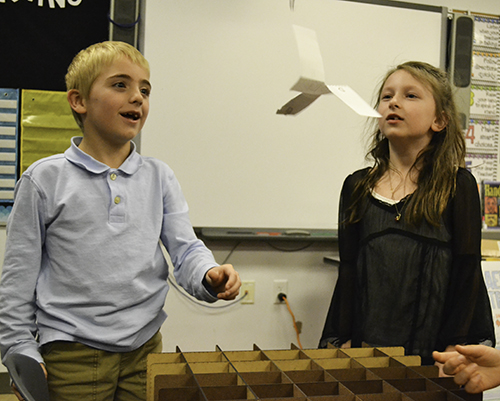
Two students enjoy the flight of a fan copter during a recent IAO outeach at Booker T Washington STEM Academy's Family Engineering Night.
December 6, 2016
As its name implies, Illini Aerospace Outreach (IAO) is all about Illinois Aerospace students sharing their love of aerospace engineering with local students. IAO’s goal? To pique students’ interest in aerospace—or STEM in general. While IAO members do numerous outreach events themselves, the organization also serves as the main point of contact for organizations and schools seeking outreach from one of Aerospace Engineering’s numerous RSOs (Registered Student Organizations). IAO’s third job? To babysit a huge, Rolls Royce Concorde airplane engine.

Elijah Chen, president of the Illini Aeriospace Outreach, next to the business end of Aerospace Engineering's big Rolls Royce Concorde engine.
IAO was begun three years ago when Rolls Royce (bet you thought they only made expensive cars!) donated a Concorde engine to Aerospace. So the organization was created to not only be in charge of the engine, but to show it off, making sure that plenty of eager young students got to see it (but not necessarily touch it!) at events such as EOH (Engineering Open House) or tours of Talbot Lab. However, it’s not just the younger students who learn from the engine; it also facilitates the instruction of Illinois Aerospace students, who study it during different classes.
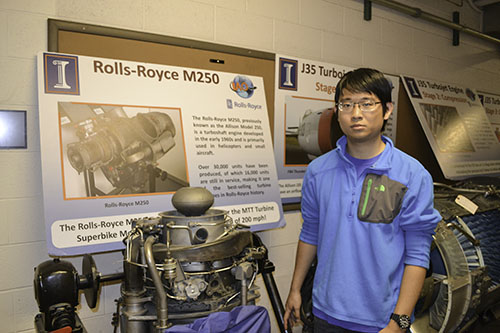
Chen by one of Aero's many smaller Rolls-Royce engines.
While minding the Rolls (and its little brothers—Aerospace has several smaller Rolls Royce engines too) was rewarding in terms of showing kids how cool Aerospace can be, the engine was obviously too big to cart around for show-and-tell. So the group also got involved in other kinds of outreach. For instance, IAO visits Champaign’s Orpheum Children’s Science Museum once a semester to do outreach.
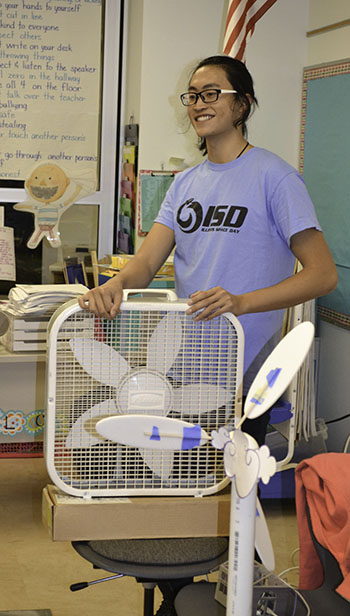
ISO's Daniel Yu explains the principles regarding the Wind Turbine project.
Plus, IAO members also do outreach in schools. This fall, for example, the group sent teams of students to Booker T. Washington STEM Academy (BTW) to work with Kindergarteners at its after-school Engineering Club, and to BTW's recent Family Engineering Night on November 29th, 2016, to work with youngsters of all ages.
IAO has perfected several hands-on activities. In one, kids build (and launch!) Alkaseltser rockets. In another, Fan Copters, kids build paper helicopters which they then “launch.” (This reporter was amazed...every single one of those babies flew at BTW's outreach, whirling around just like helicopters!) In their Wind Turbines lesson, students learn about how wind turbines provide renewable energy, then design turbine blades. While outreach lessons feature fun and exciting hands-on activities, IAO also strives to teach kids principles about aerodynamics and flight.
Along with special, one-time outreach events, IAO also partners with teachers to teach aerospace in classrooms. Each activity above is basically one lesson, with an accompanying lesson plan that covers what is being taught. Also, each lesson is aligned with Illinois’ Next Generation Science Standards and fulfills one or more of the required science elements—a big plus for teachers.
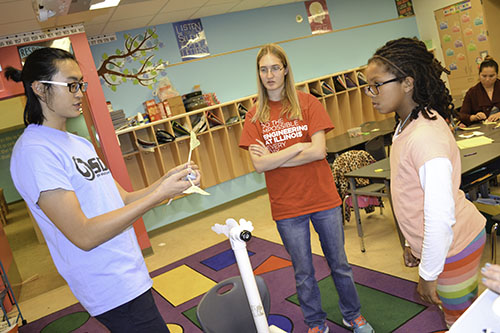
During ISO's Wind Turbine project, Daniel Yu (left) and Destiny Fawley (center) explain to a student how her turbine blades can be adjusted to generate the maximum amount of energy.
Do IAO's volunteers ever struggle to communicate college-level, very technical information down to a level kids can understand? Not really.
“Most of the stuff we do, we can explain in very simple terms,” says Elijah Chen, President of IAO. “It’s not too difficult to get to younger students.”
Plus, they’ve learned a couple of key outreach principles about engaging kids. For one, “If it involves hands-on work, they will be very excited about it,” Chen admits.
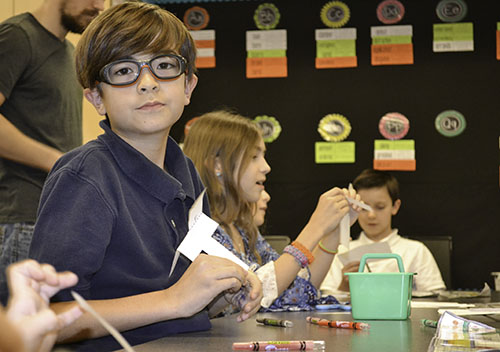
A BTW student making his Fan Copter.
Something else they’ve learned? Should things get bogged down, there's always a go-to activity that works every time: “Kids are always interested in explosions!” he admits.
Although IAO mostly works with K through middle school students, a rocket competition for local high school students is in the works for some time next spring.
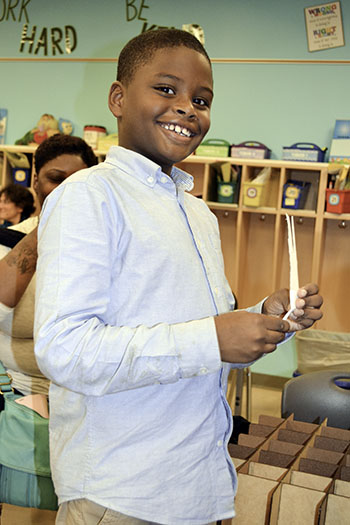
A BTW student works on his fan copter.
In addition to its members doing outreach themselves, IAO serves as an umbrella over 10–15 Aerospace Engineering RSOs. So when a school or organization wants a group of students to do outreach about aerospace, they contact IAO, whose executive board then does the legwork to schedule one or more groups to accommodate them.
Chen, a junior in aero, whose dream job is to design airplanes for Boeing, explains his passion for outreach:
“I just want to teach younger students what aerospace is. I feel like the younger the student is, and the earlier they are exposed, the more likely they will go into aerospace engineering. I just like teaching younger students what I do. It’s a really fun topic, and it’s very exciting.”
Another member of IAO’s Executive Board, vice president, Elle Wroblewski, was on hand to supervise outreach activities at BTW’s recent Family Engineering Night.

ISO's Elle Wroblewski, explains about lift during the Fan Copter project.
A 3rd year grad student pursuing her PhD in Aerospace, Wroblewski seeks to reduce drag (the force [the wind or air resistance] that opposes, or pushes in the opposite direction, as an aircraft moves through the air). She tests wings that have been theoretically optimized to minimize drag, and is also is developing a hybrid electric drivetrain simulation to be implemented into a full-scale, aircraft performance model.
Her dream job? To make the industry less damaging to the environment by improving the efficiency of aircraft to reduce harmful greenhouse gas emissions.
Wroblewski got involved in IAO because, as a kid, nobody came to her school to teach her what Aerospace Engineering was; so she hopes to remedy that for some of today's kids.
“I think that for kids, being exposed to engineering concepts in a fun, hands-on way can be really beneficial for how they view engineering later.”
She particularly hopes to target girls before they reach their pre-teen and teen years, which research has shown to be a “black hole” in terms of science: “I know that once girls reach middle school and high school, they're much more likely to stop being interested in science, from a lot of institutional and societal factors.”
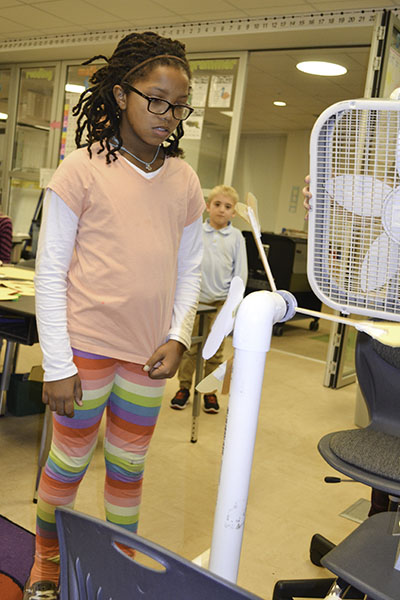
A BTW student tests the wind turbine blades she designed, which successfully generated enough power to light up the LED on the turbine.
She also hopes to boost kids’ confidence that they can do STEM: “I'm hoping that by being involved in my community, I can help kids who might not ever think, 'Hey, I could do this,' about engineering to realize they are actually interested in it. From my perspective, being interested in it is all it really takes—since that's what can motivate you to put in the work."
Wroblewski believes succeeding in engineering (or STEM in general) is not so much about being super smart, but being super motivated.
"A lot of people don't feel like they can hack it, like it's something only super-geniuses can do (the rocket-scientist stereotype doesn't really help). But it really just takes hard work and persistence, just like any other career. I think bringing engineering to schools and showing students that they can be engineers really breaks down some of those misconceptions, and could help kids be more likely to embrace STEM fields.”
BTW's proximity to campus, and the fact that it's a STEM school, gives its kids a lot more exposure to engineering compared to kids at other schools. Wroblewski thinks that gives BTW students an edge.
“I think that continually meeting with and learning from engineers at Illinois can help cement the idea that they are more than capable of being engineers themselves. I think it helps for them to make a connection between what they might learn about in class to meeting people who do the work in real life in a fun, educational setting.”
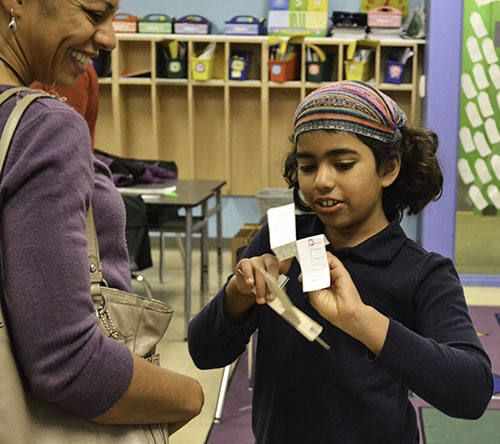
A BTW student (right) shows her mom the fan copter and glider she made during the outreach.

A mom watches as her son designs and constructs wind turbine blades, which he's almost ready to test.
According to Wroblewski, Kids aren’t the only ones who need convincing that they could be engineers. Sometimes their parents need to be convinced as well. And she believes events like BTW’s Family Engineering Night help to convince them.
“Because one of the barriers that kids can face when thinking about their future is their parents not understanding what options there are out there. By working with kids and parents, I think it makes it more likely for parents to realize that their kid has more options than they might have thought. Which would help them be more supportive, regardless of what their kids end up wanting to pursue.”
Did Wroblewski see any future aerospace engineers at BTW? “I think all of them could be aerospace engineers!” she exclaims, along with the caveat: “They're so young; they've got at least eight or nine years to make that decision.”
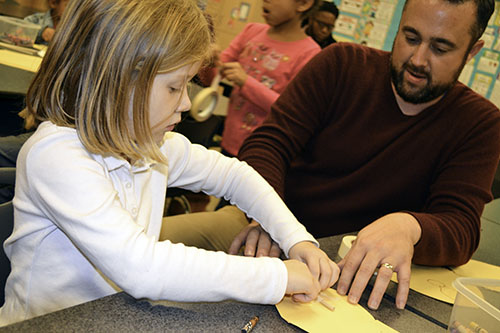
A BTW student creates her wind turbine blades with the assistance of her dad, BTW Principal Ryan Cowell.
However, she admits to seeing "lots of kids in elementary school who are interested in planes and know a lot about rockets and spacecraft already.” Ironically, although she's at Illinois working on a Ph.D. in aero, she says that when she was a youngster she was, “really into birds and wanted to be a veterinarian!” But maybe she didn't actually stray all that far from her initial interest; after all, she was interested in things that fly.
According to Wroblewski, the goal of outreach should be to give youngsters confidence that they can do or be anything they want:
“I think the most important thing is to realize that anybody can do anything. It's our job as adults in STEM fields to expand what 'anything' is for kids by making science engaging and exciting.”
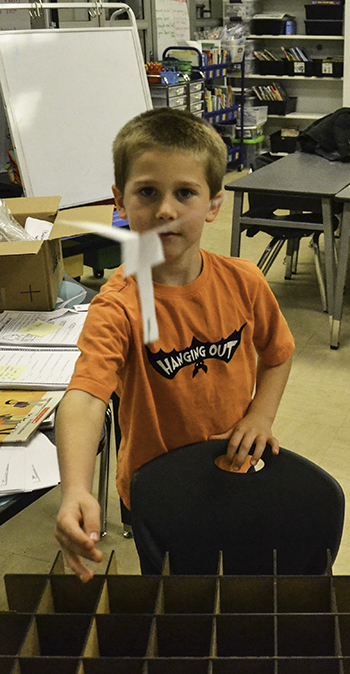
A young BTW student tests the aircraft he built during the Fan Copter project.
Story and photographs by Elizabeth Innes, Communications Specialist, I-STEM Education Initiative.
More: Booker T. Washington, K-6 Outreach, K-12 Outreach, Aerospace Engineering, 2016
For additional I-STEM web articles about Illinois' partnership with Booker T. Washington STEM Academy, see:
- Cowell, BTW's Family Engineering Fair Send a Message: STEM = Fun
- MechSE Grads Milner & Armstrong Trade in Sports Outreach for STEM Via ENVISION
- BTW Kindergarteners Have a Ball Learning About Polymers, Manufacturing
- Booker T. Washington and Illinois: Partnering to Improve STEM Education
- Booker T. Washington Students Down on the Prairie Fruits Farm
- Illinois Students Expose Youngsters to Engineering in BTW's After-School Club
- Outreach-Minded Engineering Students Hope to Steer Local Youth into STEM
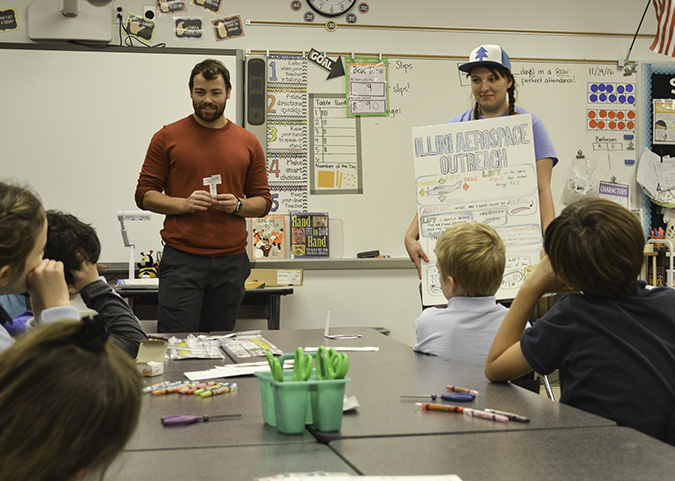
Elle Wroblewski (standing, far right) and another Illinois student teach children about aerodynamics at BTW's recent Family Engineering Night.













.jpg)
















